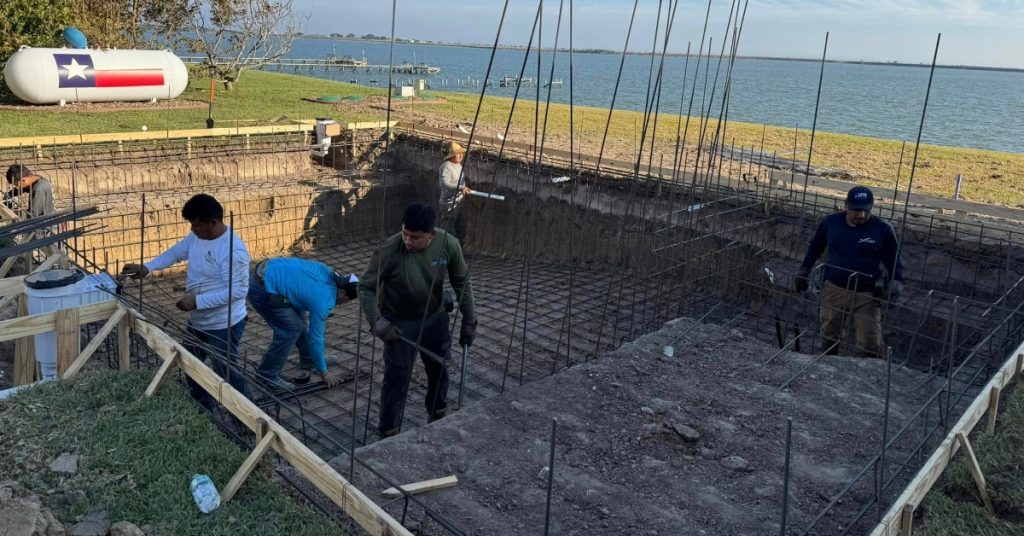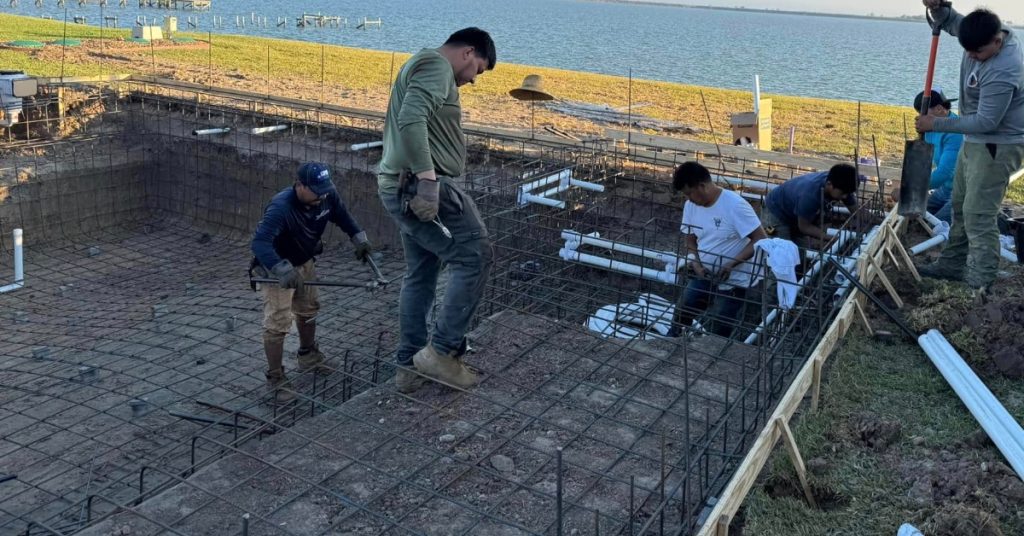Rebar 101: Its Purpose in Pool Construction

When building an inground pool, one of the most critical elements lies beneath the surface: rebar. Short for “reinforcing bar,” rebar is a steel rod used in concrete construction to increase tensile strength, ensuring the structure can withstand external pressures and natural forces over time.
Rebar serves as the skeletal framework for pool construction, providing durability, stability, and resistance to cracking.
This “Rebar 101: Understanding Its Purpose in Pool Construction” guide dives into the purpose of rebar in pool construction, its benefits, and why proper installation is essential for a successful inground pool project.
What is Rebar?
A rebar is a steel reinforcement rod typically made from carbon steel. Its ribbed surfaces improve its adhesion to concrete, forming a bond that prevents cracking under stress. Rebar is available in various sizes, lengths, and grades, making it versatile for construction projects ranging from high-rise buildings to residential swimming pools.
Rebar forms the foundation of pools. It is laid out in a grid or web-like pattern and later embedded in shotcrete or gunite, two types of concrete commonly used for pool shells. This combination ensures the pool can handle water weight, ground movement, and other environmental factors.
The Purpose of Rebar in Pool Construction
Enhances Structural Integrity
Concrete is strong in compression but weak in tension. It can crack under stress from shifting soil, water pressure, or temperature changes without reinforcement. Rebar compensates for this by absorbing tension and preventing the concrete shell from failing under these conditions.
Increases Durability
Rebar significantly extends a pool’s lifespan by reinforcing the concrete. Pools with properly installed rebar are less likely to experience structural issues, such as cracks or leaks, even decades after installation.
Supports Complex Shapes
Modern pools often feature intricate designs with curves, steps, and custom features like tanning ledges and spas. The rebar can be bent and shaped to accommodate these designs, ensuring every part of the pool is adequately reinforced.
Prevents Cracking and Movement
Pools are significantly stressed by water pressure and the natural movement of the surrounding soil. Rebar creates a stable framework that distributes these forces evenly, reducing the likelihood of cracks or structural movement.
How Rebar is Used in Pool Construction

Design and Layout
The process begins with designing the rebar layout, typically based on the pool’s shape, size, and features. Engineers then calculate the necessary spacing and thickness to meet structural requirements.
Rebar Installation
The rebar is cut, bent, and arranged on-site according to the design specifications. Installers tie the rods together with wire at intersecting points, creating a grid-like structure. This grid is then secured with supports to maintain its position during concrete application.
Concrete Application
Once the rebar framework is in place, it is encased in gunite or shotcrete. These materials are sprayed over the rebar, bonding with the steel and forming a solid, reinforced structure.
Inspection and Quality Control
Before applying concrete, the rebar framework undergoes rigorous inspection to ensure it meets local building codes and structural standards. This step is crucial for preventing future issues.
Common Rebar Mistakes to Avoid
- Incorrect Spacing or Overlap: Improper spacing between the rebar rods or inadequate overlapping can weaken the pool’s structure, leading to cracks or instability.
- Using Low-Quality Materials: Substandard rebar can eventually corrode and fail. Therefore, it’s vital to use high-grade, corrosion-resistant steel.
- Improper Tying or Securing: If the rebar grid is not tied securely, it may shift during the concrete application, compromising the pool’s integrity.
- Failure to Follow Codes: Every region has specific building codes for pool construction, including rebar installation. Non-compliance can lead to legal issues, fines and costly repairs.
How to Maintain Rebar Integrity Over Time
- Regular Pool Inspections: Cracks or leaks in a pool can expose rebar to moisture, leading to corrosion. Regular inspections can help catch and address issues early.
- Proper Pool Maintenance: Proper water chemistry prevents the pool environment from becoming too acidic, which can corrode rebar over time.
- Professional Repairs: If cracks or structural issues are detected, consult an experienced pool builder to assess and repair the damage promptly. Ignoring such problems can further deteriorate the rebar and pool structure.
The Importance of Hiring Professionals for Rebar Installation
Rebar installation is not a do-it-yourself (DIY) project. It requires precise calculations, specialized tools, and a deep knowledge of pool engineering. Professional pool builders, like Escape Pools & Spas, serving Spring, Texas, and beyond, have the expertise to design and install rebar frameworks that meet the highest industry standards.
In addition, Escape Pools & Spas ensures compliance with local building codes, giving you peace of mind that your pool is built to last.
Benefits of Proper Rebar Installation
- Longevity: A well-reinforced pool can last for decades with minimal structural issues.
- Safety: Rebar strengthens the pool, reducing the risk of sudden failures or collapses.
- Value: Pools with robust construction retain value over time, making them a worthwhile investment.
- Customization: Properly installed rebar allows for creative designs and custom features without compromising strength.
Strength You Can Rely On: The Hidden Hero of Your Dream Pool
Rebar may not be the most visible element of your pool, but its importance cannot be overstated. From providing structural integrity to supporting custom designs, rebar forms the backbone of any high-quality inground pool. Whether envisioning a simple backyard oasis or a luxurious resort-style pool, proper rebar installation ensures your investment will last.
When building your dream pool, trust the experts at Escape Pools & Spas in Spring, Texas. Our pool builder team specializes in design and custom inground pool construction. We prioritize quality craftsmanship and strict attention to detail, guaranteeing customer satisfaction.
Contact Escape Pools & Spas today to get started on a pool built to last.
